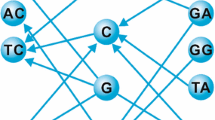Abstract
This paper proposes a genetic code Boolean structure derived from hydrogen bond numbers and chemical types of bases, purines and pyrimidines. It shows that in such Boolean structure, deductions comprise physico-chemical meaning. In particular, codons with adenine as a second base coding to hydrophilic amino acids are not deductible from codons with uracil in the same position, which code to hydrophobic amino acids. Boolean deductions could help us describe the gene evolution process. For instance, most of the reported mutations that confer drug resistance to the HIV protease gene correspond to deductions. What is more, in the human beta-globin gene a similar situation appears where most of the single codon mutations correspond to Boolean deductions from the respective wild-type codon.
Similar content being viewed by others
References
Alf-Steinberger, C., 1969. The genetic code and error transmission. Proc. Natl. Acad. Sci. USA 64, 584–591.
Balakrishnan, J., 2002. Symmetry scheme for amino acid codons. Phys. Rev. E 65, 021912–021915.
Bashford, J.D., Jarvis, P.D., 2000. The genetic code as a periodic table. Biosystems 57, 147–161.
Bashford, J.D., Tsohantjis, I., Jarvis, P.D., 1998. A supersymmetric model for the evolution of the genetic code. Proc. Natl. Acad. Sci. USA 95, 987–992.
Beland, P., Allen, T.F., 1994. The origin and evolution of the genetic code. J. Theor. Biol. 170, 359–365.
Bertman, M.O., Jungck, J.R., 1979. Group graph of the genetic code. J. Hered. 70, 379–384.
Birkhoff, G., MacLane, S., 1941. A Survey of Modern Algebra. The Macmillan Company, New York.
Chothia, C., 1974. Hydrophobic bonding and accessible surface area in proteins. Nature 248, 338–339.
Crick, F.H.C., 1968. The origin of the genetic code. J. Mol. Biol. 38, 367–379.
Epstein, C.J., 1966. Role of the amino-acid ‘code’ and of selection for conformation in the evolution of proteins. Nature 210, 25–28.
Friedman, S.M., Weinstein, I.B., 1964. Lack of fidelity in the translation of ribopolynucleotides. Proc. Natl. Acad. Sci. USA 52, 988–996.
Gillis, D., Massar, S., Cerf, N.J., Rooman, M., 2001. Optimality of the genetic code with respect to protein stability and amino acid frequencies. Genome Biol. 2, research0049.1-research0049.12.
Grantham, R., 1974. Amino acid difference formula to help explain protein evolution. Science 185, 862–864.
He, M., Petoukhov, S.V., Ricci, P.E., 2004. Genetic code, Hamming distance and stochastic matrices, Bull. Math. Biol. (in press).
Jimńez-Montaño, M.A., de la Mora-Basanet, C.R., Poschel, T., 1996. The hypercube structure of the genetic code explains conservative and non-conservative amino acid substitutions in vivo and in vitro. Biosystems 39, 117–125.
Jiménez-Montaño, M.A., 1999. Protein evolution drives the evolution of the genetic code and vice versa. Biosystems 54, 47–64.
Karasev, V.A., Stefanov, V.E., 2001. Topological nature of the genetic code. J. Theor. Biol. 209, 303–317.
Karplus, P.A., 1997. Hydrophobicity regained. Protein Sci. 6, 1302.
Lehmann, J., 2000. Physico-chemical constraints connected with the coding properties of the genetic system. J. Theor. Biol. 202, 129–144.
Parker, J., 1989. Errors and alternatives in reading the universal genetic code. Microbiol. Rev. 53, 273–298.
Robin, D., Knight, R.D., Freeland, S.J., Landweber, L.F., 1999. Selection, history and chemistry: the three faces of the genetic code. Trends Biochem. Sci. 24, 241–247.
Rose, G.D., Geselowitz, A.R., Lesser, G.J., Lee, R.H., Zehfus, M.H., 1985. Hydrophobicity of amino acid residues in globular proteins. Science 229, 834–838.
Siemion, I.Z., Siemion, P.J., Krajewski, K., 1995. Chou-Fasman conformational amino acid parameters and the genetic code. Biosystems 36, 231–238.
Stambuk, N., 2000. Universal metric properties of the genetic code. Croatica Chem. Acta 73, 1123–1139.
Author information
Authors and Affiliations
Corresponding author
Rights and permissions
About this article
Cite this article
Sánchez, R., Morgado, E. & Grau, R. A genetic code Boolean structure. I. The meaning of Boolean deductions. Bull. Math. Biol. 67, 1–14 (2005). https://doi.org/10.1016/j.bulm.2004.05.005
Received:
Accepted:
Issue Date:
DOI: https://doi.org/10.1016/j.bulm.2004.05.005




